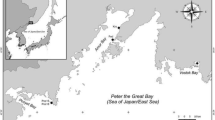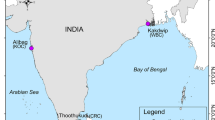Abstract
The Japanese scallop (Mizuhopecten yessoensis) is one of the main fishery products in Japan, but with the expansion of culture operations of the Japanese scallop, various problems have been encountered including high mortality, poor growth, poor seed production, and so on. Moreover, there is concern that many years of cultivation may have affected the genetic structure of the scallop population. To approach these problems and concerns, we developed microsatellite markers as a molecular tool for population genetic studies. By using 4 microsatellite markers as well as a mitochondrial marker, we investigated the genetic structure of samples from the islands of Hokkaido (14 populations) and Honshu (Tohoku, 3 populations) in Japan, and south Primorye (4 populations) in Russia. All the populations sampled had high genetic diversity (average expected heterozygosity, 0.7011 to 0.7622; haplotype diversity, 0.6090 to 0.8848), and almost all showed a tendency of homozygote excess, which was significant in 2 populations. Hierarchical analysis of molecular variance tests based on the microsatellite and mitochondrial markers indicated that the 3 geographic regions were genetically divergent from one another, with little evidence of divergence within regions. Homogeneity in allele frequency distributions between natural and cultured scallops and allele frequency stability over a period of 2 decades indicated that the culturing operations have probably not had a substantial effect on the genetic structure of the populations.


Similar content being viewed by others
References
Castillo AGF, Martinez JL, Garcia-Vazquez E (2004) Fine spatial structure of Atlantic hake (Merluccius merlccius) stocks revealed by variation at microsatellite loci. Mar Biotechnol 6:299–306
Crow JF, Kimura M (1965) Phylogenetic analysis: models and estimation procedures. Am J Hum Genet 19:233–257
Dolganov SM, Pudovkin AI (1997) Genetic Diversity of the Scallop Mizuhopecten (Patinopecten) yessoensis Jay, 1856 from primorye. Russian Journal of Genetics 33:138–1394
Dolganov SM, Pudovkin AI (1998) Population-genetic structure of the Japanese scallop Mizuhopecten (Patinopecten) yessoensis from Sakhalin Island and the southern Kuril Islands. Russian J Geneti 34:1411–1419
Edwards KJ, Barker JHA, Daly A, Jones C, Karp A (1996) Microsatellite libraries enriched for several microsatellite sequences in plants. Biotechniques 20:758–760
Excoffier L, Smouse PE, Quattro JM (1992) Analysis of molecular variance inferred from metric distances among DNA haplotypes: application to human mitochondria DNA restriction date. Genetics 131:479–491
Fujio Y, Brand EV (1991) Differences in degree of homozygosity between seed and sown population of the Japanese scallop Patinopecten yessoensis. Nippon Suisan Gakkaishi 57:45–50
Garoia F, Guarniero I, Piccinetti C, Tinti F (2004) First microsatellite loci of red mullet (Mullus barbatus) and their application to genetic structure analysis of Adriatic shared stock. Mar Biotechnol 6:446–452
Goudet J (1995) FSTAT Version 1.2: a computer program to calculate F statistic. J Hered 86:485–486
Holland BS (2001) Invasion without a bottleneck; microsatellite variation in natural and invasive populations of the brown mussel Perna perna (L). Mar Biotechnol 3:407–415
Iguchi K, Ohkawa T, Nishida M (2002) Genetic structure of land-locked ayu within the Biwa Lake system. Fisheries Sci 68:138–143
Iyengar A, Piyapattanakorn S, Stone DM, Heipel DA, Howell BR, Baynes SM, Maclean N (2000) Identification of microsatellite repeats in turbot (Scophthalmus maximus) and Dover sole (Solea solea) using a RAPD-based technique: characterization of microsatellite markers in Dover sole Mar Biotechnol 2:49–56
Kijas JMH, Fowler JCS, Garbett CA, Tomas MR (1994) Enrichment of microsatellites from the citrus genome using biotinylated oligonucleotide sequences bound to streptavidin-coated magnetic particles. Biotechniques 16:56–662
Kijima A, Mori K, Fujio Y (1984) Population differences in gene frequency of Japanese scallop Patinopecten yessoensis on the Okhotsk Sea Coast of Hokkaido. Bull Jpn Soc Sci Fish 50:241–248
Kumagai K, Barinova AA, Nakajima M, Taniguchi N (2004) Genetic diversity between Japanese and Chinese threeline grunt (Parapristipoma trilineatum) examined by microsatellite DNA markers. Mar Biotechnol 6:221–228
Launey S, Hedgecock D (2001) High genetic load in the Pacific oyster Crassostrea gigas. Genetics 159:155–165
Marshall TC, Slatem J, Kruuk LEB, Pemberton JM (1998) Statistical confidence for likelihood-based paternity inference in natural populations. Mol Ecol 7:639–655
Miller MP (1999) Tools for population genetic analysis [TFPGA] 1.3: a Windows program for population genetic data. Available at http://www bioweb.usu.edu/mpmbio/tfpga.asp
Nagashima K, Sato M, Kawamata K, Nakamura A, Ohta T (2005) Genetic structure analysis of the Japanese scallop population in Hokkaido, analyzed by mitochondrial haplotype distribution. Mar Biotechnol 7, 1–10
Nei M (1978) Estimation of average heterozygosity and genetic distance from a small number of individuals. Genetics 89:583–590
Oniwa K, Kijima A, Fujio Y (1994) Relationship between genetic variability and quantitative traits in the Japanese scallop Patinopecten yessoensis. Tohoku J Agr Res 45:1–10
Pudovkin AI, Zaylkin DV, Dolganov SM (1998) Interlocus association of allozyme genotypes in settlements of the scallop Mizuhopecten (Patinopecten) yessoensis in coastal waters of Primorye. Russian J Geneti 34:385–392
Rice RW (1989) Analyzing tables of statistical tests. Evolution 43:223–225
Sato M, Nagashima K (2001) Molecular characterization of a mitochondria DNA segments from the Japanese scallop (Patinopecten yessoensis): demonstration of a region showing sequence polymorphism in population. Mar Biotechnol 3:370–379
Sato S, Kojima H, Ando J, Wilmot RL, Seeb LW, Efemov V, LeClair L, Buchholz W, Jin D, Urawa S, Kaeriyama M, Urano A, Abe S (2004) Genetic population structure of chum salmon in the Pacific Rim inferred from mitochondrial DNA sequence variation. Environ Biol Fish 69:38–50
Schneider S, Kueffer JM, Roessi D, Excoffier L (1997) AREQUIN Version 1.1: a software for population genetic data analysis. (Geneva, Switzerland: Genetics and Biometry Laboratory, University of Geneva)
Sekino M, Hamaguchi M, Aranishi F, Okoshi K (2003) Development of novel microsatellite DNA markers from the Pacific oyster Crassostrea gigas. Mar Biotechnol 5:227–233
Shaw PW, Turan C, Wright JM, O’Connel M, Carvalho GR (1999) Microsatellite DNA analysis of population structure in Atlantic herring (Clupea harengus), with direct comparison to allozyme and mtDNA RFLP analysis. Heredity 8:490–499
Supungul P, Sootnan P, Klinbunga S, Komonrat W, Jarayabhand P, Tassanakajon A (2000) Microsatellite polymorphism and the population structure of the black tiger shrimp (Penaeus monodon) in Thailand. Mar Biotechnol 2:339–347
Tseng M, Chen CA, Kao H, Tzeng W, Lee S (2001) Polymorphisms of GA/GT microsatellite loci from Anguilla japonica. Mar Biotechnol 3:275–280
Valles–Jimenez R, Cruz P, Perez–Enriquez R (2005) Population genetic structure of Pacific white shrimp (Litopenaeus vannamei) form Mexico to Panama: microsatellite DNA variation. Mar Biotechnol 6:475–484
Weir B, Cockerham CC (1984) Estimating F-statistics for the analysis of population structure. Evolution 38:1358–1370
Zouros E, Foltz DW (1984) Possible explanations of heterozygosity deficiency in bivalve molluscs. Malacologia 25:583–591
Zouros E, Singh SM, Miles HE (1980) Growth rate in oysters; an overdominant phenotype and its possible explanations. Evolution 34:856–867
Yotsutani M, Kosaka Y, Fujio Y (1995) Change of homozygote excess during growth in the Japanese scallop Patinopecten yessoensis. Tohoku J Agr Res 46:35–45
Acknowledgments
We thank Mr. Akira Tanaka and Syuji Yoshikawa (Hokkaido Food Processing Research Center), and Mr. Kimihiko Maekawa (Aqua-culture Cooperation of Lake Saroma, Hokkaido, Japan) for assistance, and Professor Syuiti Abe (Graduate School of Fisheries Sciences, Hokkaido University, Hakodate, Japan) for useful advice. We also thank Dr. S. M. Dolganov (Institute of Marine Biology, Vladivostok, Russia) for the collection of samples and Dr. A. I. Pudovkin (Institute of Marine Biology, Vladivostok, Russia) for useful comments.
Author information
Authors and Affiliations
Corresponding author
Rights and permissions
About this article
Cite this article
Sato, M., Kawamata, K., Zaslavskaya, N. et al. Development of Microsatellite Markers for Japanese Scallop (Mizuhopecten yessoensis) and Their Application to a Population Genetic Study. Mar Biotechnol 7, 713–728 (2005). https://doi.org/10.1007/s10126-004-0127-8
Received:
Accepted:
Published:
Issue Date:
DOI: https://doi.org/10.1007/s10126-004-0127-8









